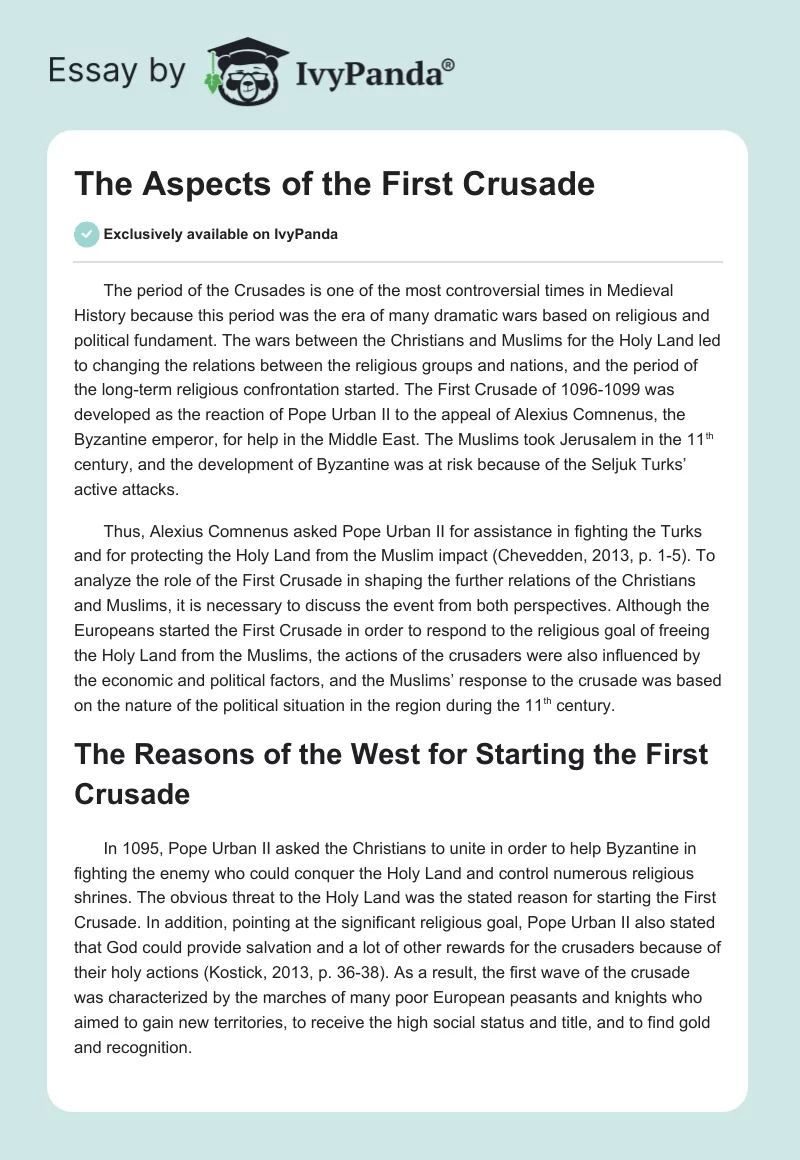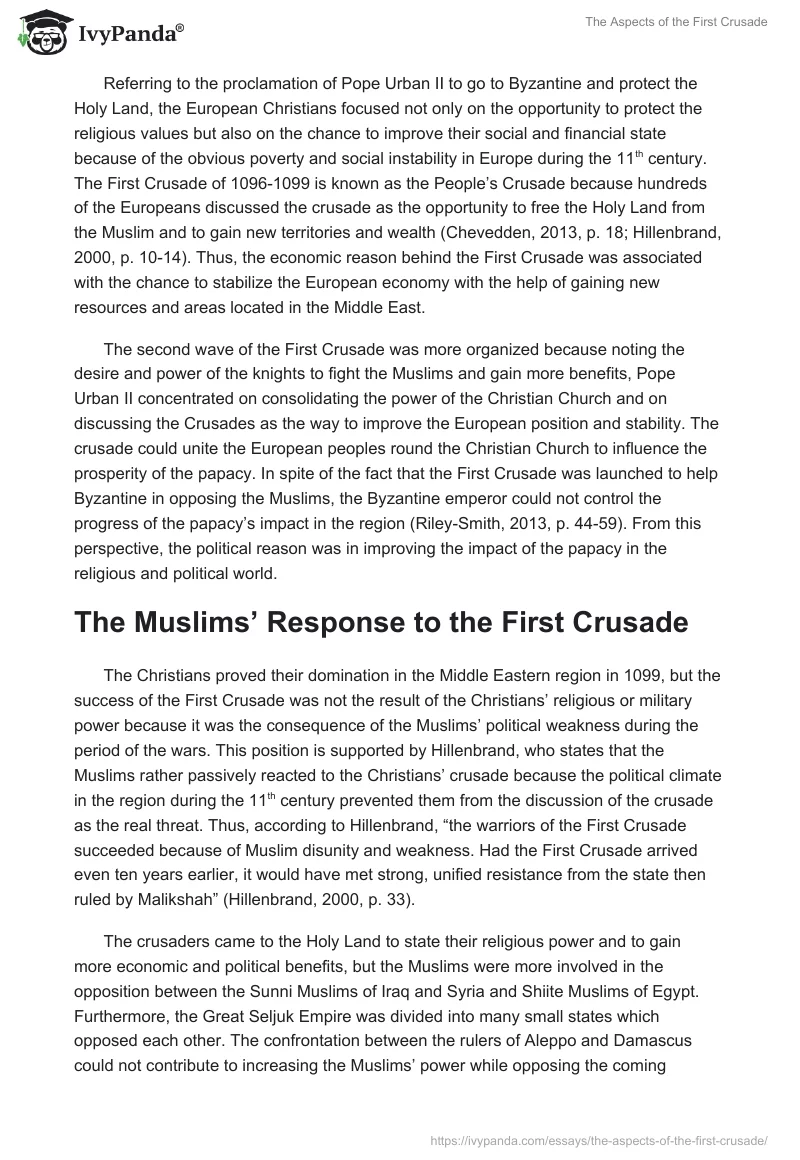The period of the Crusades is one of the most controversial times in Medieval History because this period was the era of many dramatic wars based on religious and political fundament. The wars between the Christians and Muslims for the Holy Land led to changing the relations between the religious groups and nations, and the period of the long-term religious confrontation started. The First Crusade of 1096-1099 was developed as the reaction of Pope Urban II to the appeal of Alexius Comnenus, the Byzantine emperor, for help in the Middle East. The Muslims took Jerusalem in the 11th century, and the development of Byzantine was at risk because of the Seljuk Turks’ active attacks.
Thus, Alexius Comnenus asked Pope Urban II for assistance in fighting the Turks and for protecting the Holy Land from the Muslim impact (Chevedden, 2013, p. 1-5). To analyze the role of the First Crusade in shaping the further relations of the Christians and Muslims, it is necessary to discuss the event from both perspectives. Although the Europeans started the First Crusade in order to respond to the religious goal of freeing the Holy Land from the Muslims, the actions of the crusaders were also influenced by the economic and political factors, and the Muslims’ response to the crusade was based on the nature of the political situation in the region during the 11th century.
The Reasons of the West for Starting the First Crusade
In 1095, Pope Urban II asked the Christians to unite in order to help Byzantine in fighting the enemy who could conquer the Holy Land and control numerous religious shrines. The obvious threat to the Holy Land was the stated reason for starting the First Crusade. In addition, pointing at the significant religious goal, Pope Urban II also stated that God could provide salvation and a lot of other rewards for the crusaders because of their holy actions (Kostick, 2013, p. 36-38). As a result, the first wave of the crusade was characterized by the marches of many poor European peasants and knights who aimed to gain new territories, to receive the high social status and title, and to find gold and recognition.
Referring to the proclamation of Pope Urban II to go to Byzantine and protect the Holy Land, the European Christians focused not only on the opportunity to protect the religious values but also on the chance to improve their social and financial state because of the obvious poverty and social instability in Europe during the 11th century. The First Crusade of 1096-1099 is known as the People’s Crusade because hundreds of the Europeans discussed the crusade as the opportunity to free the Holy Land from the Muslim and to gain new territories and wealth (Chevedden, 2013, p. 18; Hillenbrand, 2000, p. 10-14). Thus, the economic reason behind the First Crusade was associated with the chance to stabilize the European economy with the help of gaining new resources and areas located in the Middle East.
The second wave of the First Crusade was more organized because noting the desire and power of the knights to fight the Muslims and gain more benefits, Pope Urban II concentrated on consolidating the power of the Christian Church and on discussing the Crusades as the way to improve the European position and stability. The crusade could unite the European peoples round the Christian Church to influence the prosperity of the papacy. In spite of the fact that the First Crusade was launched to help Byzantine in opposing the Muslims, the Byzantine emperor could not control the progress of the papacy’s impact in the region (Riley-Smith, 2013, p. 44-59). From this perspective, the political reason was in improving the impact of the papacy in the religious and political world.
The Muslims’ Response to the First Crusade
The Christians proved their domination in the Middle Eastern region in 1099, but the success of the First Crusade was not the result of the Christians’ religious or military power because it was the consequence of the Muslims’ political weakness during the period of the wars. This position is supported by Hillenbrand, who states that the Muslims rather passively reacted to the Christians’ crusade because the political climate in the region during the 11th century prevented them from the discussion of the crusade as the real threat. Thus, according to Hillenbrand, “the warriors of the First Crusade succeeded because of Muslim disunity and weakness. Had the First Crusade arrived even ten years earlier, it would have met strong, unified resistance from the state then ruled by Malikshah” (Hillenbrand, 2000, p. 33).
The crusaders came to the Holy Land to state their religious power and to gain more economic and political benefits, but the Muslims were more involved in the opposition between the Sunni Muslims of Iraq and Syria and Shiite Muslims of Egypt. Furthermore, the Great Seljuk Empire was divided into many small states which opposed each other. The confrontation between the rulers of Aleppo and Damascus could not contribute to increasing the Muslims’ power while opposing the coming Christians (Hillenbrand, 2000, p. 33-38). As a result, the First Crusade was not perceived by the Muslims as the real threat to their lands and stability, and the focus of the Muslims on their own political confrontations led to their defeat in 1099.
Following the discussions of the Arab historians related to the First Crusade, it is important to note that historians paid more attention to the description of the battles and dates rather than to the reasons for the fight and effects of the defeat on the Muslim world. That is why, it is possible to state that the Muslims rejected to perceive the first Christian crusade as the statement of the Christian domination or power in the region (Gabrieli, 2009, p. 58-64). If the Christians were more focused on supporting their economic and religious ideals, the Muslims discussed the event mainly from the political perspective while assessing the impact of the crusade on the development of the Muslim states. The changes in the Muslims visions of the crusades were characteristic for the next centuries when the Christians tried to repeat their attempts in freeing the Holy Land from the Muslims.
The Effect of the First Crusade on the Modern Views of the Christians and Muslims toward Each Other
In spite of the fact that the Muslims’ reaction to the First Crusade is discussed by many historians as rather passive, the events of 1099 made the Muslims change their vision of the Christian crusades’ threat, and the further opposition between the Muslims and Christians was based on the principles of the holy war for the religious values and ideals. The risk of being defeated by the Christians one more time made the Muslims consolidate their forces and proclaim the principles of jihad against the crusaders (Gabrieli, 2009, p. 58-64). The First Crusade can be discussed as the trigger for starting the period of the prolonged religious opposition between the Christians and Muslims, which is based on the discussion of both sides’ rights on certain Middle Eastern territories.
The Crusade of 1096-1099 became one of the first steps in the religious and political opposition between the Christians and Muslims because both sides discussed their rights on the Holy Lands as supported by the historical events and cultural development. However, the basic motivations of the Christians and Muslims were different because the Christians proclaimed the religious ideals, but strived for the economic benefits, and the Muslims protected the political and territorial interests with developing the religious war against the crusaders (Hillenbrand, 2000, p. 58-60). This opposition in the Christians and Muslims’ visions and approaches to regulating the conflicts and controversial questions are also observed today, and both the Christians and Muslims are rather suspicious today in relation to each other because their visions are opposite.
Conclusion
The First Crusade is one of the important events in the history of the Christian and Muslim worlds because it was the start of multiple wars for political and religious domination at the territories of the Middle East. Although the First Crusade is the most disorganized operation of the European military forces, the crusaders succeeded in their attempt to gain control over the Holy Lands in 1099 because the Muslims were not prepared for the attacks on a religious basis.
The First Crusade resulted in the Christians in putting the economic and political goals behind the religious idea, and this crusade also resulted in the Muslims in discussing the religious war against the Christians as the main goal for the military conflict, with few references to the obvious political and economic benefits. The religious motivations of the Christians served as the shield for hiding their obvious focus on the economic and political benefits. On the contrary, the religious aspects played a more important role for the Muslims who began to discuss the war against the Christians as the holy one since the defeat after the First Crusade.
References
Chevedden, P. (2013). Crusade creationism versus Pope Urban II’s conceptualization of the Crusades. The Historian, 75(1), 1–46. Web.
Gabrieli, F. (2009). Arab historians of the Crusades. USA: Routledge. Web.
Hillenbrand, C. (2000). The Crusades: Islamic perspectives. USA: Psychology Press. Web.
Kostick, C. (2013). Courage and cowardice on the First Crusade, 1096–1099. War in History, 20(1) 32–49. Web.
Riley-Smith, J. (2013). The Crusades, Christianity, and Islam. USA: Columbia University Press. Web.


